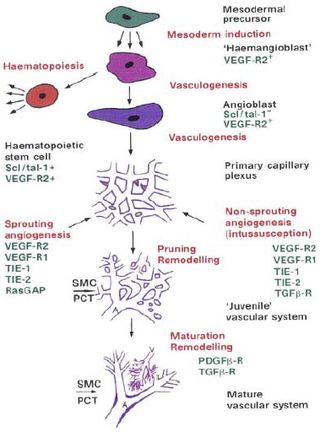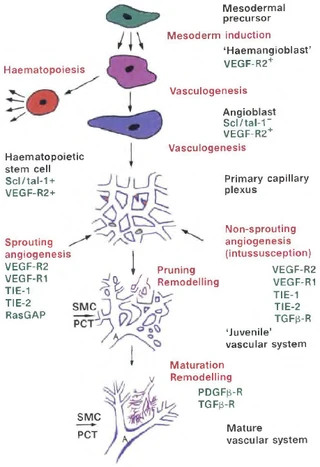von Ana Catarina Ribeiro Carrão
Statistik und Sichtungsnachweis dieser Seite findet sich am Artikelende
| [1.] Arc/Fragment 029 01 - Diskussion Zuletzt bearbeitet: 2014-02-26 22:26:58 Schumann | Arc, BauernOpfer, Fragment, Gesichtet, Risau 1997, SMWFragment, Schutzlevel sysop |
|
|
| Untersuchte Arbeit: Seite: 29, Zeilen: 1-17, legend to fig. 6 |
Quelle: Risau 1997 Seite(n): 671, 672, Zeilen: 671: left col. 22-29 - right col. 1-9.23-25; 672: legend to fig. 2; left col. 2-7 |
|---|---|

Fig. 6 – The processes (red labels), molecules (green labels) and appearances (black labels) involved in vascular development. Red tips in the primary capillary plexus represent sprouts, yellow circles represent splitting pillars. The hemangioblast as a bipotential precursor is still under debate and intermediate steps between some processes have been omitted. Remodelling and maturation is dependent on the tissue and organ context. It is schematized here from observations in the avian yolk-sac vascular system. A, arteriole; V, venule; SMC, smoothe muscle cells; PCT, pericytes71. Mesoderm inducing factors of the fibroblast growth factor family are crucial in inducing paraxial and lateral plate mesoderm to form angioblasts and hematopoietic cells. The existence of a bipotential precursor of these cell types (the so-called hemangioblast) is suggested by defects in both the hematopoietic and angioblastic lineages of embryos lacking VEGF-receptor 2 (VEGF-R2, also called Flk-1 and KDR in mice and humans, respectively). After differentiation, VEGF-R2 is downregulated in hematopoietic but not in endothelial cells. The other receptor for VEGF, VEGF-R1 (Flt-1), plays a later role, as mice lacking VEGF-R1 produce angioblasts, but their assembly into functional blood vessels is impaired75. VEGF acts in a paracrine manner as it is produced by the endoderm, whereas its receptors are expressed by mesoderm-derived angioblasts. Some angioblasts can migrate over long distances and form a vascular plexus at a site distant from the original location74. After the primary plexus is formed, more ECs are generated, which can form new capillaries by sprouting or by splitting from their vessel of origin in a process termed angiogenesis. There are at least two different types of angiogenesis: 1) nonsprouting or intussusception angiogenesis and 2) true sprouting of capillaries from preexisting vessels (Fig. 7)74. 71. Haghighat A WD, Whalin MK, Cowan DP, Taylor WR. . Granulocyte colonystimulating factor and granulocyte macrophage colony-stimulating factor exacerbate atherosclerosis in apolipoprotein E-deficient mice. Circulation. 2007;115:2049-2054. 74. Risau W. Mechanisms of angiogenesis. Nature. 1997;386:671-674. 75. Fong GH, Rossant J, Gertsenstein M, Breitman ML. Role of the Flt-1 receptor tyrosine kinase in regulating the assembly of vascular endothelium. Nature. 1995;376:66-70. |
[Page 671]
Mesoderm-inducing factors of the fibroblast growth factor family are crucial in inducing paraxial and lateral plate mesoderm to form angioblasts and haematopoietic cells. The existence of a bipotential precursor for these cell types (the so-called haemangioblast) is suggested by defects in both the haematopoietic and angioblastic lineages of embryos lacking vascular endothelial growth factor receptor-2 (VEGF-R2, also called Flk-1 and KDR in mice and humans, respectively; Fig. 2)4. But only haematopoietic stem cells are affected5,6 in embryos lacking the transcription factor Scl/tal-1. After differentiation, VEGF-R2 is downregulated in haematopoietic but not in endothelial cells. The other receptor for VEGF, VEGF-R1 (Flt-1), plays a role later, as mice lacking VEGF-R1 produce angioblasts, but their assembly into functional blood vessels is impaired7. VEGF itself acts in a paracrine manner as it is produced by the endoderm, whereas its receptors are expressed by mesoderm-derived angioblasts. [...] Rather than forming blood vessels where they originate, some angioblasts migrate over long distances12, forming a vascular plexus at a distant site (such as the perineural vascular plexus). [Page 672] Figure 2 The processes (red labels), molecules (green labels) and appearances (black labels) involved in vascular development. Red tips in the primary capillary plexus represent sprouts, yellow circles represent splitting pillars (Fig. 3). The haemangioblast as a bipotential precursor is still hypothetical and intermediate steps between some processes have been omitted. Remodelling and maturation is dependent on the tissue and organ context. It is schematized here from observations in the avian yolk-sac vascular system. A, arteriole; V, venule; SMC, smooth muscle cells; PCT, pericytes. None of the figures is drawn to scale. [...] After the primary vascular plexus is formed, more endothelial cells are generated, which can form new capillaries by sprouting or by splitting from their vessel of origin in a process termed angiogenesis. There are at least two different types: true sprouting of capillaries from pre-existing vessels, and non-sprouting angiogenesis or intussusception (Figs 2 and 3). 4. Shalaby, F. et al. Failure o f blood-island formation and vasculogenesis in flk-1-deficient mice. Nature 376, 62-66 (1995). 5. Porcher, C. et al. The T cell leukemia oncoprotein Scl/Tal-1 is essential for development of all hematopoietic lineages. Cell 86, 47-57 (1996). 6. Robb, L. et al. The Scl gene product is required for the generation of all hematopoietic lineages in the adult mouse. EMBO J. 15, 4123-4129 (1996). 7. Fong, G. H., Rossant, J., Gertsenstein, M. & Breitman, M. L. Role of the fit-1 receptor tyrosine kinase in regulating the assembly of vascular endothelium. Nature 376, 66-70 (1995). 8. Carmeliet, P. et a l Abnormal blood vessel development and lethality in embryos lacking a single VEGF allele. Nature 380, 435-439 (1996). 9. Ferrara, N. et al. Heterozygous embryonic lethality induced by targeted inactivation of the VEGF gene. Nature 380, 435-439 (1996). 12. Noden, D. M. in The development of the vascular system (eds Feinberg, R. N., Sherer, G. K. & Auerbach, R.) 1-24 (Karger, Basel, 1991). |
Although the source is given (in passing) nothing has been marked as a citation. The material is mostly copied verbatim. Figure 6 and its legend are also taken from Risau (1997), without the source being named. The source given Haghighat et al. (2007) does not contain any of the copied material. |
|
Letzte Bearbeitung dieser Seite: durch Benutzer:WiseWoman, Zeitstempel: 20140226083032
